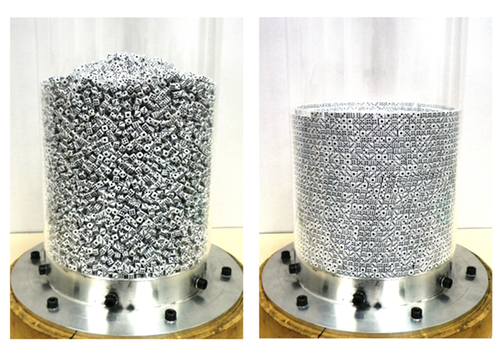Dice Become Ordered When Stirred, Not Shaken
Repeatedly tap on a box of marbles or sand and the pieces will pack themselves more tightly with each tap. However, the contents will only approach its maximum density after a long time and if you use a carefully crafted tapping sequence. But in new experiments with a cylinder full of dice vigorously twisted back and forth, the pieces achieved their maximum density quickly. The experiments could point to new methods to produce dense and technologically useful granular systems, even in the zero gravity environments of space missions.
Granular matter is common in nature and in industry, from the sand and gravel of the building trade to powders in foods and pharmaceutical manufacturing. Under the influence of gravity, simple vibration or tapping can make granular matter grow more compact over time, as dislodged particles find ways to fall further down with each shake. Industrial plants use this effect with powders and grains of many kinds.
Exploring other ways to pack granular matter, Diego Maza and colleagues from the University of Navarra in Spain experimented with plastic dice in an upright cylinder subjected to oscillating rotations about its vertical axis. They observed gradual packing but also found that the effects of twisting are quite different from those of tapping.
The team first poured 25,000 dice, each roughly a half centimeter on a side, into a cylindrical container. They then began twisting the container, rotating it alternately clockwise and counterclockwise about once per second and continued for several hundred thousand twists. The rotation exerted a force on the dice directed outward toward the walls, and the oscillation provided periodic jolts at the two moments during each cycle when the rotation direction reversed. The team varied the strength of these jolts by adjusting the speed of the steady rotation between reversals.
The results show that the degree of dice ordering depends strongly on the rotational acceleration applied at each reversal. For accelerations above about half the acceleration of gravity (0.5 g), the dice reach a final state of maximum density after about 10,000 twists. In this state, the dice lie in horizontal layers within the cylinder and also in nearly perfectly ordered concentric rings within each layer. In contrast, for accelerations below 0.5 g, the packing proceeds so slowly that it is unclear if the dice would ever reach the state of maximum density. Even after 100,000 twists, the dice near the center of the cylinder remain highly disorganized. Maza and colleagues estimate that it might take ten years of twisting to reach the maximum density.
These results, says Maza, show a very different packing process for twisting than for tapping. A tapped granular system, even a collection of cubes, won't reach a state of maximum density on its own but tends to get stuck in a state of intermediate density. It can only be made more dense through a process called annealing, in which the tapping grows more gentle over time. In contrast, for strong enough twisting, the dice always reach the most dense state without any annealing.
“The experiments are solid and quite clean,” says statistical physicist Matthias Schröter of the Max Planck Institute for Dynamics and Self-Organization in Göttingen, Germany, who suggests that the process by which the dice become ordered is similar to that of other systems. For example, contact with a boundary can trigger the formation of crystalline order in a collection of colloidal particles suspended in a liquid; the dice may be similarly influenced by the outer cylinder wall. “What they have observed,” says Schröter, “is heterogeneous nucleation, or the growth of crystalline order induced by the boundaries.”
Maza agrees that this might well be the explanation and hopes the method might find uses in settings where the usual packing by tapping procedure doesn’t work, such as in the absence of gravity. Maza and his colleagues are preparing experiments for the International Space Station, aiming to study the dynamics of granular materials under microgravity conditions. To achieve useful densities, they've been using moving pistons to produce vibrations roughly equivalent to tapping, but they may explore the twisting method in future work.
This research is published in Physical Review Letters.
–Mark Buchanan
Mark Buchanan is a freelance science writer who splits his time between Abergavenny, UK, and Notre Dame de Courson, France.





